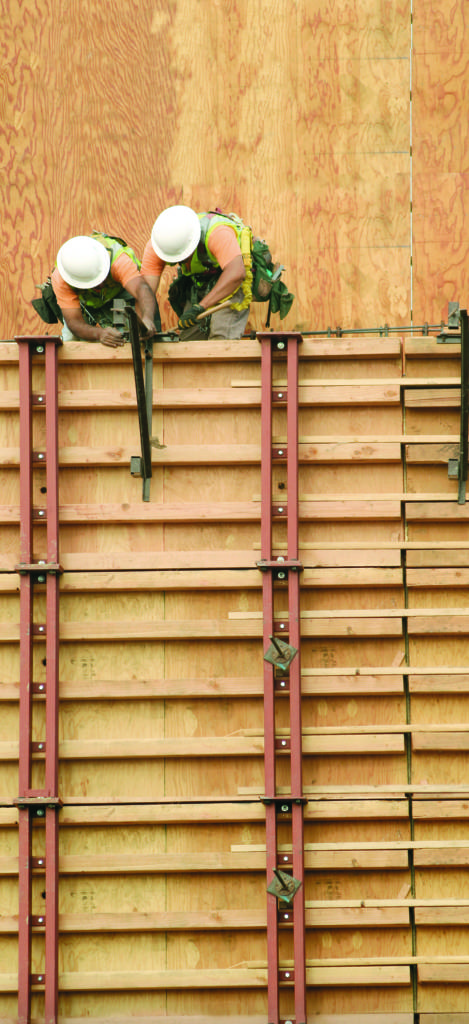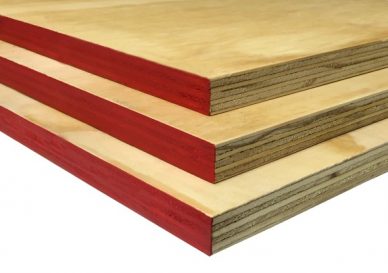If you’ve ever wondered, “Is plywood used for concrete forms?” Well, you’re in the right place! Let’s dive into this interesting topic.
Now, when it comes to building concrete structures, plywood can indeed be used as a versatile material for creating sturdy and reliable concrete forms.
But hold on, what exactly are concrete forms? Concrete forms are temporary molds or structures that hold the concrete in place until it sets and hardens. And guess what? Plywood, with its strength and flexibility, can be an excellent choice for constructing these forms.
So, if you’re curious to learn more about how plywood is used for concrete forms, just keep reading! We’ll explore the benefits, considerations, and even some useful tips along the way. Let’s get started!
Plywood is commonly used for concrete forms due to its versatility and strength. It provides a smooth surface for pouring concrete and can be easily installed and removed. Plywood is cost-effective compared to other form materials and is readily available in various sizes. It is also durable and can withstand the pressure exerted by wet concrete. Additionally, plywood can be reused multiple times, making it an eco-friendly option for concrete formwork.

Is Plywood Used for Concrete Forms?
In the construction industry, concrete forms are essential for shaping and molding concrete structures. One common material used for creating these forms is plywood. Due to its strength, durability, and cost-effectiveness, plywood is widely utilized as a formwork material. In this article, we will explore the reasons behind the popularity of plywood for concrete forms, its benefits and drawbacks, as well as provide some expert tips for using plywood effectively in construction projects.
The Advantages of Plywood for Concrete Forms
When it comes to selecting the appropriate material for concrete forms, plywood offers numerous advantages. Firstly, plywood is highly flexible, allowing it to be easily cut, shaped, and assembled into various form designs. This flexibility is particularly beneficial in complex construction projects where unique formwork shapes are required. Moreover, plywood possesses excellent strength-to-weight ratio, making it lightweight and easy to handle on-site. Its strength also enables it to withstand the pressure exerted by wet concrete without warping or deforming.
Another advantage of plywood is its affordability. Compared to other formwork materials like steel or aluminum, plywood is significantly cheaper, making it a cost-effective choice for contractors and builders. Additionally, plywood is readily available in various thicknesses and sizes, providing versatility in formwork design. This availability and versatility make plywood a practical choice that can accommodate different project requirements.
Lastly, plywood is known for its reusability. With proper maintenance and care, plywood formwork can be used for multiple construction projects. This durability not only reduces material waste but also offers significant cost savings over time. By utilizing plywood for concrete forms, construction companies can improve their overall sustainability and environmental impact.
Tips for Using Plywood in Concrete Forms
While plywood brings several benefits to concrete formwork, it is crucial to follow certain guidelines to ensure optimal performance and longevity. Here are some expert tips for using plywood effectively in construction projects:
1. Choose the Right Type of Plywood
Not all plywood is suitable for concrete forms. It is essential to select a type of plywood that has been specifically designed and treated for formwork purposes. Look for plywood with high water resistance and a smooth surface for easy removal of concrete after curing.
2. Use Adequate Thickness
The thickness of plywood used for concrete forms depends on the height and pressure exerted by the concrete. Consult with structural engineers or formwork experts to determine the appropriate thickness required for your specific project.
3. Apply a Release Agent
To prevent the concrete from sticking to the plywood, it is essential to apply a release agent on the surface before pouring the concrete. This will facilitate easy removal of the formwork once the concrete has cured.
4. Reinforce Corners and Edges
The corners and edges of plywood forms are susceptible to damage from constant use and concrete pressure. Reinforce these areas with additional material or metal angles to ensure durability and prevent premature failure.
5. Provide Adequate Support
Plywood formwork should be adequately supported to withstand the weight of the wet concrete. Use strong and properly braced frames or shoring systems to ensure stability and prevent formwork failure.
6. Maintain and Store Properly
After each use, clean the plywood formwork thoroughly and store it in a dry and well-ventilated area. Proper storage and maintenance will extend the lifespan of the plywood and ensure its reusability for future projects.
The Verdict: Plywood is Ideal for Concrete Forms
In conclusion, plywood is indeed a popular and suitable material for concrete forms. Its flexibility, strength, affordability, and reusability make it an ideal choice for construction projects. By selecting the right type of plywood, using proper thickness, applying release agents, reinforcing corners and edges, providing adequate support, and maintaining the formwork, contractors can maximize the benefits of plywood and achieve efficient and successful concrete formwork.
Key Takeaways: Is Plywood Used for Concrete Forms?
- Yes, plywood is commonly used for concrete forms.
- Plywood is a versatile material that is affordable and easy to work with.
- It is important to choose the right type of plywood for concrete forms, such as exterior grade plywood.
- Plywood forms can be reused multiple times, making them a cost-effective option.
- Proper preparation, including sealing the plywood and using release agents, is essential for successful concrete pouring.
Frequently Asked Questions
When it comes to concrete forms, plywood is a commonly used material. It offers versatility and durability, making it a practical choice for various construction projects. Here are some frequently asked questions about using plywood for concrete forms.
Q: What makes plywood a suitable material for concrete forms?
A: Plywood is widely used for concrete forms due to its strength, stability, and cost-effectiveness. It provides a smooth surface for casting concrete and can withstand the pressures exerted by the poured concrete without warping or bending. Its layers of thin wood veneers glued together create a sturdy structure that can hold the shape of the form during the concrete pouring process. Plywood is also readily available and can be easily cut into the desired shape and size, making it a convenient choice for constructing concrete forms.
Additionally, plywood can be reused multiple times, making it a cost-effective option for contractors. After the concrete has cured, the formwork can be removed, cleaned, and used for future projects, reducing waste and saving money in the long run.
Q: What precautions should be taken when using plywood for concrete forms?
A: While plywood is a suitable material for concrete forms, there are some precautions to consider. It is essential to use plywood that is specifically designed for formwork to ensure it can withstand the pressure and moisture of wet concrete. Using regular plywood may result in warping or delamination, compromising the integrity of the form.
Proper bracing and support should also be implemented to prevent the plywood from bowing or collapsing under the weight of the concrete. Reinforcing the formwork with additional supports and braces, especially for tall or complex forms, will help maintain their structural integrity.
Q: Can plywood be reused after being used as concrete forms?
A: Yes, plywood can be reused for concrete forms, making it a sustainable option. After the concrete has set and the formwork is removed, the plywood can be cleaned, inspected for any damage, and used again for future projects. Proper storage and maintenance are essential to ensure the longevity of the plywood forms.
However, it is important to note that the number of times plywood can be reused depends on various factors, such as the quality of the plywood, the type and thickness of the concrete, and the care taken during form removal. Regular inspections should be conducted to identify any signs of damage or wear that could compromise the form’s integrity. By following proper maintenance practices, plywood can be reused multiple times, maximizing its value and reducing waste.
Q: Are there any alternatives to plywood for concrete forms?
A: While plywood is a popular choice for concrete forms, there are alternative materials available. One common alternative is metal forms, usually made of steel or aluminum. Metal forms offer durability, strength, and the ability to create precise and consistent form shapes. However, they can be more expensive and heavier than plywood.
Another alternative is plastic forms, which are lightweight, reusable, and easy to handle. They are typically made of high-density polyethylene (HDPE) or fiberglass-reinforced plastic (FRP). Plastic forms offer good resistance to moisture and can create a smooth finish on the concrete surface. However, they may not be suitable for all types of concrete projects and may have limitations in terms of form size and shape.
Q: Can plywood be used for curved concrete forms?
A: Yes, plywood can be used for creating curved concrete forms. To achieve curved forms, plywood can be cut into narrower strips and then bent or curved to the desired shape. These curved strips can be fastened together to form the complete formwork. By using plywood with sufficient thickness and flexibility, it is possible to create various curved shapes for concrete. However, it is crucial to ensure proper bracing and support to maintain the form’s shape during the concrete pouring and curing process.
For more complex curved forms, specialized techniques such as kerfing or lamination may be used to achieve the desired curvature. Kerfing involves making cuts at regular intervals along the length of the plywood, allowing it to bend more easily. Lamination involves layering multiple thin plywood sheets, gluing them together to create a curved form. Both techniques require precise planning and attention to detail to achieve successful curved concrete forms.

Concrete Wall Forming with Plywood, Snap Ties, and Wedges Part 1
Summary
So, to wrap things up, plywood can be used for making concrete forms. It’s a versatile and cost-effective option for construction projects. However, it’s important to choose the right type of plywood and treat it properly to ensure durability and a smooth finish. Plywood is a valuable material that helps in creating strong and stable concrete structures.
In conclusion, plywood can be a great choice for making concrete forms because it is affordable, easy to work with, and provides the necessary strength and support. Just make sure to select the right plywood and follow the recommended practices to achieve desirable results. So go ahead and build amazing structures with the help of plywood!
